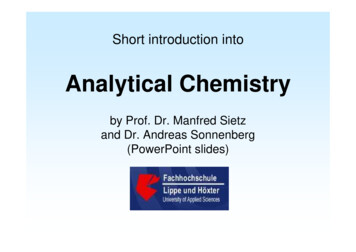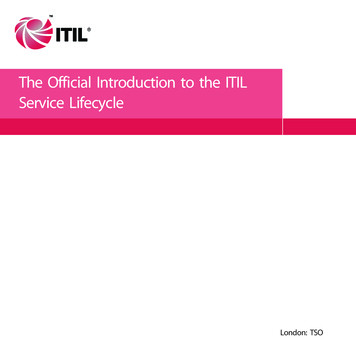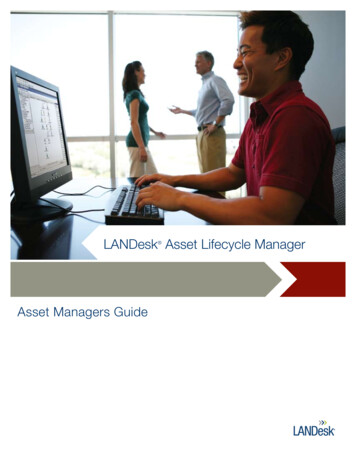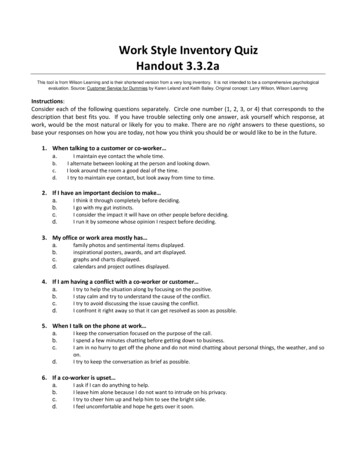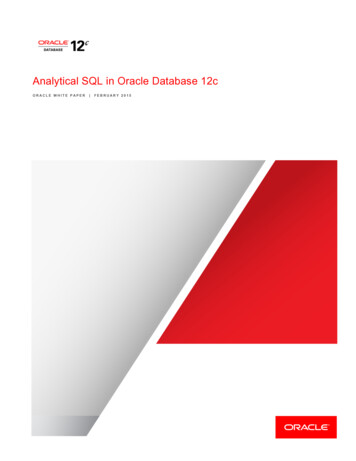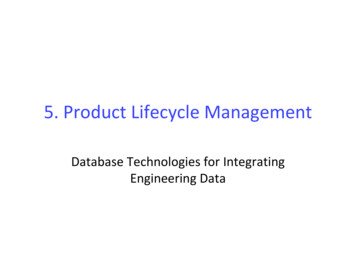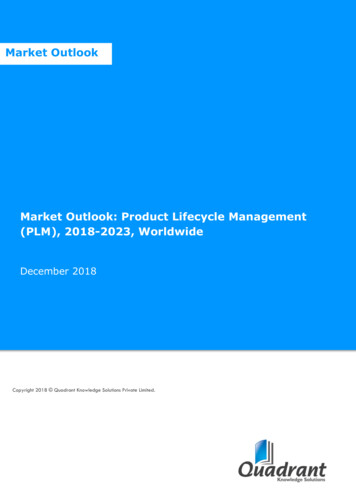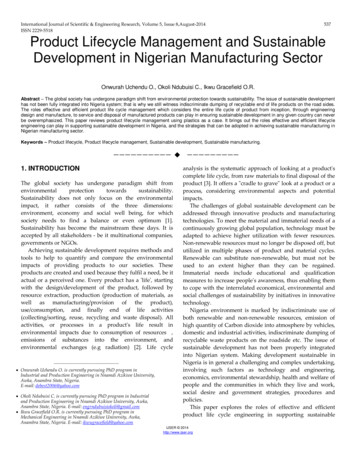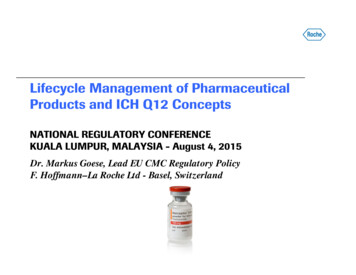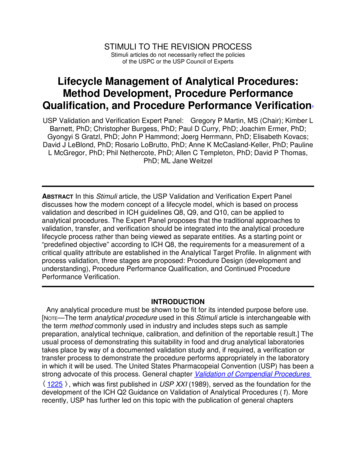
Transcription
STIMULI TO THE REVISION PROCESSStimuli articles do not necessarily reflect the policiesof the USPC or the USP Council of ExpertsLifecycle Management of Analytical Procedures:Method Development, Procedure PerformanceQualification, and Procedure Performance VerificationaUSP Validation and Verification Expert Panel: Gregory P Martin, MS (Chair); Kimber LBarnett, PhD; Christopher Burgess, PhD; Paul D Curry, PhD; Joachim Ermer, PhD;Gyongyi S Gratzl, PhD; John P Hammond; Joerg Herrmann, PhD; Elisabeth Kovacs;David J LeBlond, PhD; Rosario LoBrutto, PhD; Anne K McCasland-Keller, PhD; PaulineL McGregor, PhD; Phil Nethercote, PhD; Allen C Templeton, PhD; David P Thomas,PhD; ML Jane WeitzelABSTRACT In this Stimuli article, the USP Validation and Verification Expert Paneldiscusses how the modern concept of a lifecycle model, which is based on processvalidation and described in ICH guidelines Q8, Q9, and Q10, can be applied toanalytical procedures. The Expert Panel proposes that the traditional approaches tovalidation, transfer, and verification should be integrated into the analytical procedurelifecycle process rather than being viewed as separate entities. As a starting point or“predefined objective” according to ICH Q8, the requirements for a measurement of acritical quality attribute are established in the Analytical Target Profile. In alignment withprocess validation, three stages are proposed: Procedure Design (development andunderstanding), Procedure Performance Qualification, and Continued ProcedurePerformance Verification.INTRODUCTIONAny analytical procedure must be shown to be fit for its intended purpose before use.[NOTE—The term analytical procedure used in this Stimuli article is interchangeable withthe term method commonly used in industry and includes steps such as samplepreparation, analytical technique, calibration, and definition of the reportable result.] Theusual process of demonstrating this suitability in food and drug analytical laboratoriestakes place by way of a documented validation study and, if required, a verification ortransfer process to demonstrate the procedure performs appropriately in the laboratoryin which it will be used. The United States Pharmacopeial Convention (USP) has been astrong advocate of this process. General chapter Validation of Compendial Procedures1225 , which was first published in USP XXI (1989), served as the foundation for thedevelopment of the ICH Q2 Guidance on Validation of Analytical Procedures (1). Morerecently, USP has further led on this topic with the publication of general chapters
Verification of Compendial Procedures1224 (Figure 1).1226and Transfer of Analytical ProceduresFigure 1. Current typical process for analytical procedures.The intent of ICH Q2 and 1225 was to provide guidance to the industry about howto validate different types of analytical procedures. This guidance was intended to beused in combination with sound scientific judgment to ensure that appropriateexperiments applicable to different analytical procedures and situations would beperformed on a case-by-case basis. Over time, however, these documents have cometo be interpreted as mandatory expectations rather than scientific guidance. Althoughthese practices are successful in many cases, there are opportunities to further refineand improve them. The ICH and USP documents provide guidance pertaining toprocedure suitability as part of the procedure validation exercise (e.g., accuracy,precision, linearity, specificity, etc.), but they do not provide a framework that allowsusers to reliably understand and control sources of variability. Similar observations weremade in the manufacturing process development area, leading to development of thelifecycle management process described in ICH Q8, Q9, and Q10 (and more recentlyQ11) (2–5). Taking these ICH documents into consideration, the USP Validation andVerification Expert Panel has reevaluated the current validation, verification, andtransfer guidelines for analytical procedures.The lifecycle concept described in ICH Q8 is adaptable to analytical procedures if weconsider an analytical procedure as a process and the output of this process as thereportable result, that is, the value that will be compared to the acceptance criterion.The purpose of applying lifecycle principles to analytical procedures is to holisticallyalign analytical procedure variability with the requirements of the product to be testedand to improve the reliability of the procedure by understanding, reducing, andcontrolling sources of variability. Enhanced understanding of variables that affect theperformance of an analytical procedure provides greater assurance that the quality
attributes of the tested product can be reliably assessed. The lifecycle managementprocess provides a framework for defining the criteria for and development of ananalytical procedure that meets the acceptance criteria. The procedure then becomespart of a continuous verification cycle to demonstrate that it meets the predefinedcriteria over the life of the procedure. Implementation throughout the procedure'slifecycle of a change management process that is based on knowledge gained duringthe procedure's lifetime ensures that the procedure remains fit for its intended use. Keyto the general approach is an understanding of overall variability, including variabilityarising from the manufacturing process as well as the analytical procedure. A focus ofUSP has been understanding the variability of its reference materials, which are part ofthe total variability that should be understood, controlled and, where possible, reduced.In this Stimuli article, the USP Validation and Verification Expert Panel discusses howthe modern concept for process validation (6,7), which is based on a lifecycle model,can be applied to analytical procedures (8–11). We propose that the traditionalapproaches to validation, transfer, and verification should be integrated into theanalytical procedure lifecycle process rather than being viewed as separate entities.The Validation and Verification Expert Panel proposes that the concepts addressed in1225 , 1226 , and 1224 should be revised and compiled into a single newgeneral information chapter, Lifecycle Management of Analytical Procedures 1220and a new general chapter 220 specifying the basic requirements.The Validation and Verification Expert Panel seeks reader comments on the contentsof this Stimuli article.THE LIFECYCLE APPROACHResults generated using analytical procedures provide the basis for key decisionsregarding compliance with regulatory, compendial, and manufacturing limits. The resultsare applied against Decision Rules that give a prescription for the acceptance orrejection of a product based on the measurement result, its uncertainty, and acceptancecriteria, taking into account the acceptable level of the probability of making a wrongdecision (12,13).The adoption of a lifecycle approach to ensure the quality of pharmaceutical productshas been extensively discussed during the past several years (2–7). The concept ofQuality by Design (QbD) is understood as a “systematic approach that begins withpredefined objectives and emphasizes product and process understanding and processcontrol, based on sound science and quality risk management” (ICH Q8). Application oflifecycle management concepts to analytical procedures provides an opportunity to usethe knowledge gained from the application of scientific approaches and quality riskmanagement to continual improvement and assurance of data quality.There should be an effective Quality Management System in place consistent with ICHQ10. The concepts described in ICH Q10 complement current GMPs, thus providing anintegrated model for a pharmaceutical or similar quality system. This supports continualimprovement across the entire lifecycle of the analytical procedure.The Analytical Target Profile (ATP), risk management, control strategy, and knowledgemanagement are cornerstone concepts in lifecycle management, which will bediscussed in the following sections.Analytical Target Profile
A fundamental component of the lifecycle approach to analytical procedures is havinga predefined objective that stipulates the performance requirements for the analyticalprocedure. These requirements are derived from the Analytical Target Profile (ATP).See Figure 2 for some examples.Figure 2. Examples of Potential Analytical Target Profiles. [NOTE—Items in bracketsand italics (variables listed as capital letters and numerical values) are placeholders tobe replaced by specific items for an ATP.]The concept of an ATP parallels the concept of a Quality Target Product Profiledescribed and defined in ICH Q8. The ATP defines the requirements for the “product” ofthe test procedure, which in this case is the reportable result. Criteria defined in the ATPrefer to the quality data attributes of the reportable result, i.e., accuracy andmeasurement uncertainty, which include all sources of variability, including precision.Identifying the output of the analytical procedure as the reportable result provides atarget for development and helps to ensure the procedure is developed towardpredetermined performance requirements that are directly linked to the quality of thedata. In other words, the ATP defines the objective of the test and quality requirements,including the expected level of confidence, for the reportable result that allows thecorrect conclusion to be drawn regarding the attributes of the material that is beingmeasured. It is essential to reach a high degree of confidence that an analyticalprocedure will consistently generate reportable results that meet the ATP requirementsunder all conditions of use and as the material progresses through the lifecycle.The ATP is based on the understanding of the target measurement uncertainty, whichis the maximum uncertainty that the data should have in order to maintain acceptablelevels of confidence in data quality. This introduces key performance attributes andchanges the way we currently define and evaluate analytical performancecharacteristics. The ATP serves as a reference point for assessing the fitness of ananalytical procedure not only in the development phase but also during all changeswithin the analytical lifecycle and is not linked to a specific analytical method. It isconceivable that more than one analytical procedure can meet the requirement of anATP. Any analytical procedure that has been demonstrated to be capable to generatedata that conform to the performance requirements established in the ATP would beregarded as acceptable (USP general chapter Elemental Impurities—Procedures 233
and USP Medicines Compendium general chapter Assessing Validation Parametersfor Acceptable Procedures 10 ).Existing procedures also can be evaluated in terms of their ability to meet an ATP.When using a compendial procedure for the first time, an ATP can be derived frommonograph specifications, a performance-based monograph, and any existingknowledge of the product.In assessing new or existing procedures for their capability to meet an ATP, analystscan use statistical methods for analyzing prospectively designed studies (14). In thecase of existing procedures for which significant historical data are available, statisticalprocedures for retrospective evaluation of historical data such as stability data,laboratory investigations, check samples/controls, release data, and others areavailable (15,16). The level of variability present in the historical data may triggeradditional studies that aim to understand and reduce or eliminate sources of variabilityand improve the data quality to meet ATP.Risk ManagementA high degree of confidence is needed that the analytical method will generatereportable results that meet the ATP requirements under all conditions of use as themethod progresses through the lifecycle. Application of Quality Risk Management(QRM) concepts and tools (ICH Q9) can be valuable in providing a mechanism ofachieving this. QRM for analytical procedures can be defined as a systematic processfor the assessment, control, communication, and review of risks to the quality of dataacross the product lifecycle. Process mapping tools and Ishakawa diagrams can beemployed to ensure a rigorous approach is used in identifying all potential variables thatmay affect data quality. The variables should include all aspects of the full analyticalprocedure (Figure 3), i.e., sampling, sample preparation, standards, reagents, facility,and equipment operating conditions. The identified variables then should be evaluatedusing appropriate risk-assessment tools and prioritized experimentation to understand,eliminate, or mitigate areas of risk. An approach known as CNX (Control, Noise,Experimental) can help classify all identified variables. A decision can be madeconcerning which variables should be controlled (C), which are potential noise factors(N), and which should be examined experimentally (X) to determine acceptable ranges.As part of this exercise analysts should provide and document justifications (priorknowledge, scientific rationale, or others) for the assignments made. Risk-analysis toolscan then be used to screen experimental (X) variables for DOE studies to minimize thetotal number of experiments conducted while maximizing knowledge gained. The resultsof DOE studies then provide justification of the critical variables and their acceptableranges (from the risk assessment and experimental work), are inputs in the AnalyticalControl Strategy, and are explicitly specified in the analytical procedure (Figure 4).
Figure 3. Analytical procedural variables to consider for risk assessment and controlstrategy.Figure 4. Quality risk management, control strategy, and knowledge management:how they work together.Analytical Control StrategyA well-developed control strategy, i.e., a planned set of controls, is derived fromcurrent product and process understanding. The variables and their acceptable ranges(from the risk assessment or experimental work) should be explicitly specified in the
procedure. The controls can include variables and aspects related to the sample,sample preparation, standards, reagents, facility, equipment operating conditions,historical experience (prior knowledge), the format of the reportable value (e.g., numberof replicates), and frequency of monitoring and control. The Analytical Control Strategyplays a key role in ensuring that the ATP is realized throughout the lifecycle and alsoshould be considered throughout the lifecycle as part of development, continualimprovement, and change management. Different control strategies may be required atdifferent sites. A scientific risk-based approach can be applied to the assessment of acontrol strategy's suitability across different sites, and quality risk management toolsshould be used to guide these activities. As an integral part of the laboratoryqualification to execute a compendia procedure, the process of quality risk managementshould be carried out, and the control strategy of the compendia procedure should beverified or expanded in order to ensure that the requirements of the ATP are met.Knowledge ManagementKnowledge management can be defined as a systematic approach to acquiring,analyzing, storing, and disseminating information related to products, manufacturingprocesses, and components. Knowledge management is an important factor in ensuringthe ongoing effectiveness of the control strategy. Knowledge management shouldinclude but is not limited to development activities, technology transfer activities tointernal sites and contract laboratories, validation studies over the lifecycle of theanalytical procedure, and change management activities. The knowledge gathered todevelop the method understanding should be collected in a repository and shared asneeded to support implementation of the control strategy across sites that use theanalytical procedure. Changes and improvements to an analytical procedure should bemade with reference to the method knowledge repository, which contains theinformation from the various stages of the method lifecycle.We believe that applying a lifecycle approach (Figure 5) to analytical procedures willbetter ensure that quality objectives are met on a consistent basis.Figure 5. Summary of proposed analytical procedure lifecycle approach.Lifecycle Stages
In order to provide a holistic approach to controlling an analytical procedure throughoutits lifecycle, we propose a three-stage concept that is aligned with current processvalidation terminology: Stage 1—Procedure Design (development and understanding)Stage 2—Procedure Performance QualificationStage 3—Continued Procedure Performance Verification.These steps are illustrated in Figure 6 and are discussed in the following text.
Figure 6. Three stages in the proposed lifecycle approach.[NOTE—Refer to Continual Improvement (below) for a description of the different typesof change.]STAGE 1—PROCEDURE DESIGN
Procedure Development and Understanding (Identify and Study PotentialAnalytical Variables)Once the ATP is established and the requirements for data quality (accuracy anduncertainty) of the reportable result are defined, it is the responsibility of the analyst toselect an appropriate technology and analytical procedure likely to meet therequirements of the ATP. Consequently, the ATP will be translated into the keyperformance characteristics of the intended analytical procedure.The next step is to gain an understanding of how potential sources of variability in theproposed analytical procedure affect the performance characteristics of the procedure.Tools such as process maps and Ishikawa diagrams (fishbones) can be used to providestructure to a brainstorming and information-gathering exercise. Risk-assessment tools(see ICH Q9 for examples) then can be used to identify potential procedural variablesthat may need to be controlled to ensure procedure performance and to prioritizeexperimentation to eliminate or mitigate areas of risk. CNX can help classify all thevariables. As part of this exercise it is important to provide justifications (for example,prior knowledge or scientific rationale) for the assignments made.Based on historical knowledge and an assessment of risk, analysts can make anddocument decisions about which variables will be classified as C and fixed and whichvariables will be classified as X and investigated experimentally. During the proceduredevelopment phase, analysts identify certain variables that are fundamental to theprocedure design, e.g., detector or column type. These are classed as control variablesand are not further explored during the procedure-understanding phase of Stage 1.Experimental Robustness StudiesExperimental robustness studies address the variations that may occur as theprocedure is performed on different occasions. These studies consider both continuousand categorical X (eXperimental) variables. Continuous variables (e.g., temperature,pH, or flow rate) typically are studied via design of experiments (DoE). For thesecontinuous variables, the output of the DoE study could be a procedure design spacewithin which the procedure performance is ensured. For categorical variables (likecolumn packing batch, type of instrument, etc.) the DoE study attempts to highlightvariables that could have a significant effect on procedure performance regardingaccuracy and precision, although these variables may have an even greater effect laterin the life cycle. During this study, variables may be identified and may be consideredtoo difficult or expensive to control. These are defined as Noise (N) variables in the CNXscheme. Although N variables are not directly studied at this stage, they are assessedindirectly as part of the Stage 2 activities when a laboratory has to confirm that theanalytical control strategy is adequate to allow the procedure to produce reportableresults that meet the requirements of the ATP in a particular environment. Example Nvariables include environmental and routine operating conditions.As a result of the robustness study, a set of operational procedure controls withrespect to the C and X variables are defined as part of the Analytical Control Strategy.When uncontrolled categorical variables may result in unacceptable procedureperformance, analysts should consider including a check or system suitability test (e.g.,chromatographic resolution, symmetry factors, etc.). When such a check is included, itis good practice in the analytical procedure to explain the purpose of the check and thespecific categorical variables it is designed to monitor.
Knowledge Gathering and PreparationThis step focuses on ensuring that any location where the procedure is intended to beoperated is adequately prepared to use the procedure. It is the transition step betweenStage 1 and Stage 2 where effective communication channels need to exist betweenthe laboratories. The knowledge gathered to develop the procedural understandingshould be shared as needed in support of the implementation of the control strategyacross sites that intend to use the analytical procedure.The extent of the knowledge required should take into account the level of preexistingknowledge of the analysts at the new location with respect to the product, analyticalmethod, or procedure. The analytical procedure conditions and detailed operatingcontrols, along with all of the knowledge and understanding generated during the designphase and any performance history should be conveyed to or summarized for staff atthe location where the analytical procedure will be used.STAGE 2—PROCEDURE PERFORMANCE QUALIFICATIONThe objective of this stage is to demonstrate that the procedure is fit for purpose. Thisstage confirms the analytical procedure is capable of delivering reproducible data thatconsistently meet the performance criteria defined in the ATP while operated subject tothe noise variables that may be experienced. Therefore, procedure performancequalification must be performed before routine application of the analytical procedure bythe user laboratory.Procedure performance qualification is carried out either to qualify a new procedure orto revise the conditions or operating environment of an established procedure.Showing an analytical procedure is fit for purpose involves demonstrating that thedefined analytical procedure will, under routine operating conditions, produce data thatmeet the target measurement uncertainty defined in the ATP. The procedureperformance qualification experiments, e.g., precision studies, should be designed tochallenge analytical performance characteristics that relate to the ATP requirementsand should be based on sound science and risk as well as prior knowledge andunderstanding.The analytical procedure used in the procedure performance qualification study shouldbe based on available knowledge and understanding. The analytical control strategy willbe refined and updated as a consequence of any learning from the study. For example,further controls may be added to eliminate sources of variability that are identified in theroutine operating environment in an analytical laboratory, or replication levels (multiplepreparations, multiple injections, etc.) may be increased to reduce the overalluncertainty in the reportable result (format of the reportable result).When analysts believe there may be a residual risk of variation in the performance ofthe procedure, they may add appropriate checks to detect any unacceptable levels ofvariation in the performance of the procedure. These system suitability checks shouldfocus on analytical performance characteristics that may be affected by noise andshould be controlled to ensure the requirements of the ATP are consistently met. Forexample, if there is a residual risk of variation in separation performance due to the riskof batch-to-batch variation in column packing material and the degree of separation isknown to have an effect on the uncertainty of the data, a check may be included toensure that peak resolution is sufficient to meet the ATP requirements. Examples of
system suitability tests for chromatographic systems are described in general chapterChromatography 621 .When end users do not have access to knowledge and understanding acquired duringprocedure development, e.g., for compendial procedures, users should recognize thisadditional risk and ensure the procedure performance qualification study and local orcompendial analytical control strategy adequately mitigate associated risks. End usersalso must ensure that an appropriate control strategy for the procedure is applied.STAGE 3—CONTINUED PROCEDURE PERFORMANCE VERIFICATIONThe purpose of this stage is to provide ongoing assurance that the analyticalprocedure remains in a state of control throughout its lifecycle.This stage includes both routine monitoring of the analytical procedure's performanceand evaluation to determine if the analytical procedure, as a result of any change, is stillfit for purpose.A system or systems for detecting unplanned departures from the analytical controlstrategy is essential to accomplish this goal. Adherence to cGMP requirements,specifically, the collection and evaluation of information and data about the performanceof the procedure, allows detection of undesired variability. Evaluating the performanceof the procedure identifies problems and determines whether action must be taken tocorrect, anticipate, and prevent problems so that the procedure remains in a state ofcontrol.Routine MonitoringTrend analysis using methodologies such as control charting can be conducted on themain performance indicators to confirm that the analytical procedure remains in a stateof control.This stage should include an ongoing program to collect and analyze data that relateto analytical procedure performance, for example, from replication of samples orstandards during the analysis or by trending system suitability data. This activity alignswith the guidance in Analytical Data—Interpretation and Treatment 1010 on systemperformance verification. Close attention should also be given to any out of specificationor out of trend results generated by the analytical procedure once it is being operated inits routine environment.If, during routine monitoring of the procedure, data indicate the procedure is out ofcontrol or there is an opportunity or need for improvement, then further action is taken.There are three action triggers (see Figure 6 for examples): special-cause variation (e.g., new, unexpected phenomenom)unacceptable common cause variation (e.g., expected variability inherent in theprocedure) continual improvement.Observed VariationsDuring the investigation, particular attention should be given to special cause variation(shifts, drift, and deviation) and common cause variation (unacceptable noise) (Figure7). Variation may result when a particular procedure variable is not adequatelycontrolled. This variation may arise for a number of reasons:
A variable was not identified or adequately studied during the procedureunderstanding study (Stage 1), and therefore no proper control was defined.A variable was not identified or adequately studied during Stage 2 (precisionstudy), and therefore no proper control was defined.Series member of a set of categorical variables (not included in the DoE, Stage1) has been found to have an effect on performance (e.g., a new batch ofcolumn packing results in unacceptable performance).A control strategy was defined but not followed.A noise variable has been found to have an impact on routine performance.Investigations into inadequate performance should be thorough and well documentedand should aim to reach a conclusion about the variable that is truly the root cause.Corrective and preventive action should be taken to ensure the analytical controlstrategy is updated in the analytical procedure.Figure 7. Common variation and special variation.Continual ImprovementThroughout the procedure's lifecycle, changes may be required to improve theoperational performance or the control strategy (continual improvement). Changes mayinclude but are not limited to: inclusion of an additional control, introducing a newmethod or technology, changing the intended purpose to incorporate a new impurity ortighten specifications, or alignment with a procedure in a compendial monograph thathas been updated. The nature of the change dictates the action that should be taken,and a risk assessment should be performed to identify what action is required, and the
change should be documented. When the risk assessment identifies a change thatrequires qualification, the activities described in Stage 2 are performed. This stage alsoapplies to modifications of compendial procedures.EXAMPLES OF CHANGES AND APPROPRIATE ACTIONSChange Type 1: Changes that are within already proven ranges (within the procedure'sdesign space) are considered adjustments and do not require a procedure performancequalification study to be performed before returning to routine monitoring.Change Type 2: These are changes that are outside the already proven ranges butrequire only confirmation that the procedure continues to generate data that meet ATPrequirements. Full procedure redevelopment is not required.Change Type 3: These are changes that involve the need to operate the analyticalprocedure in a different environment. These types of changes traditionally have beentreated as a procedure-transfer exercise (or procedure verification when apharmacopeial procedure is used for the first time in a new environment).Change Type 4: This is a change that may require a new analytical procedure, but theATP remains the same. The procedure will return to the procedure development stage.Change Type 5: This change involves tightening a specification limit or a change to theintended purpose o
lifecycle management concepts to analytical procedures provides an opportunity to use the knowledge gained from the application of scientific approaches and quality risk management to continual improvement and assurance of data quality. There should be an effective Quality Man
